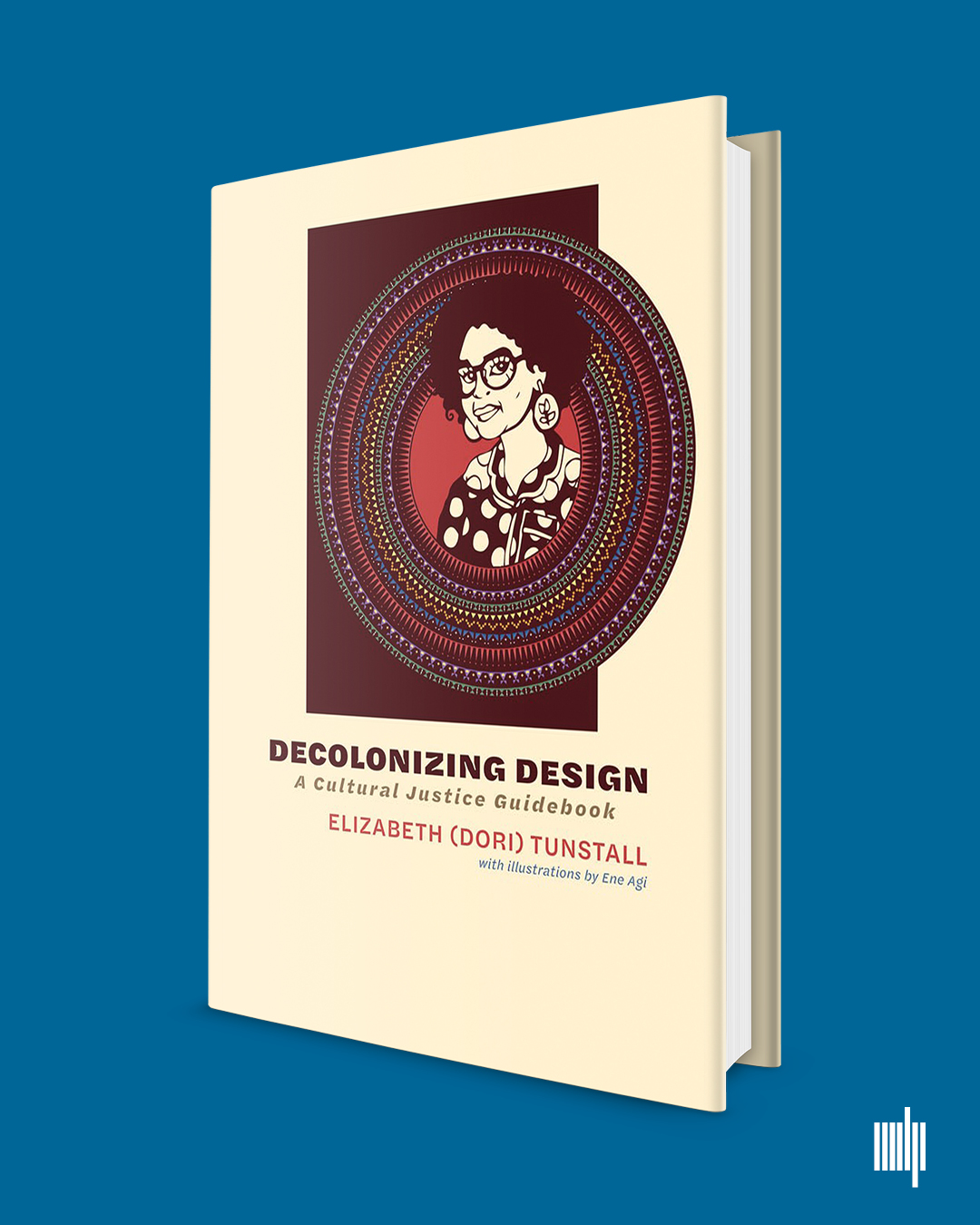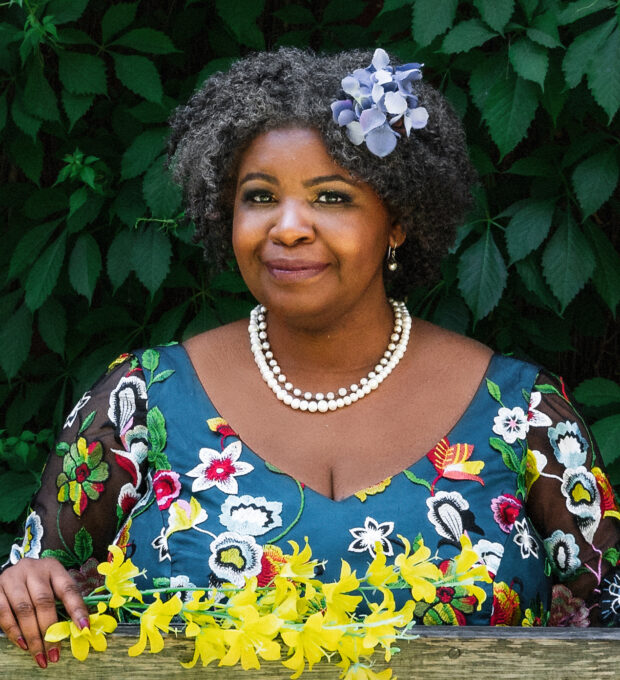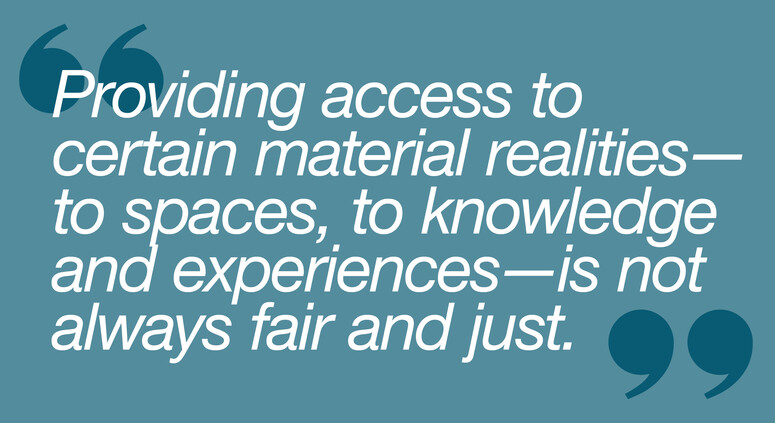ICoD interviews elizabeth (dori) tunstall on decolonising design

22.05.2023 Editorial
Interweaving lived experiences with case studies, Dr. Elizabeth (Dori) Tunstall, current Dean of OCAD's Faculty of Design (Canada) addresses both leaders and practitioners in a call to action to transform, or decolonise design—for equity, inclusion and diversity, in her new book Decolonizing Design: A Cultural Justice Guidebook (MIT Press 2023). Our conversation with Dori provides an introduction to the key concepts and teachings of this field-changing book.
In both content and design, Decolonizing Design: A Cultural Justice Guidebook (published in 2023 with The MIT Press), follows a decolonial process, highlighting designs by Indigenous and Black designers. In terms of content and design of the physical book, Tunstall built her own design team consisting of Sadie Red Wing, a Lakota and Dakota graphic designer, who developed the cover; Ene Agi, a Nigerian-Canadian illustrator, who created the illustrations; with an interior designed by Silas Munro, a Black designer, and Brian Johnson, a member of the Monacan Nation, who are both cofounders of Polymode Studio.
 Decolonizing Design by Elizabeth (Dori) Tunstall is described by MIT Press as "the long-awaited guidebook to the institutional transformation of design theory and practice by restoring the long-excluded cultures of Indigenous, Black, and People of Color communities."
Decolonizing Design by Elizabeth (Dori) Tunstall is described by MIT Press as "the long-awaited guidebook to the institutional transformation of design theory and practice by restoring the long-excluded cultures of Indigenous, Black, and People of Color communities."
ICoD: Before we get into talking about your new book, can you tell us a bit about yourself, your work trajectory in relation to design, and if possible, your relationship to the Council?
Dori: I am Dr. Dori Tunstall, Dean of the Faculty of Design at OCAD University in Toronto, Canada. I am a design anthropologist, educator, and advocate. As a design anthropologist, I look at the relationships between design and culture. As a design educator, I have taught and administered design in the USA, Australia, and Canada. As a design advocate, I have pushed for the understanding of design as a crucial cultural force. The honing of my experiences in these areas has been directly related to my attendance at ICoD conferences and symposiums, where I experienced first-hand how global cultural groups advocate for their specific histories and manifestations of design.
ICoD: What does decolonising design mean? The book shows how design might work to recenter decolonial theory and practice in global Indigenous cultures, histories and lands — to address the harms done to those excluded and oppressed by colonialism and its modernist technologies. Why is a decolonial lens and its possibilities for transformation so urgent now for professional design — as individual designers, institutions and universities that support and shape design, and the design industry as a whole?
Dori: In terms of the book, Decolonizing Design means five things:
1. Putting Indigenous First, which is recognising how the displacement of Indigenous peoples from their lands disrupted their cultural expressions through design and through that understanding, recommitting ourselves to Indigenous land and cultural sovereignty;
2. Dismantling the Tech Bias in the European Modernist Project, which is showing how the myth of “better living through technology” actually worsened conditions for the working class in Europe, and for Indigenous, Black, Asian, Latinx, and other racialised peoples everywhere by making land and labour extraction more efficient;
3. Dismantling the Racist Bias in the European Modernist Project, which is showing that the myth of design for Universal humankind was only focused on white, male, working-class bodies and excluded everyone else in a hierarchy of design with Europe at the top, China and India in the middle, and everyone else at the bottom—a hierarchy that still exists today;
4. Making Amends is More than Diversity, Equity, and Inclusion (DEI), which describes the rise of the Supertoken as the DEI solution and how by hiring in clusters and changing the criteria of evaluation to take into account systemic exclusion companies might achieve their decolonial DEI objectives; and
5. Reprioritizing Existing Resources to Decolonize*, which makes the business case for decolonizing design by demonstrating its moral case for using existing resources.
ICoD: In the opening pages, you paraphrase Toni Morrison’s words, saying Decolonizing Design was the book “I wanted to read but hadn’t been written yet” (11). You elaborate why, saying, " I wish I had a guide to help me to understand my experiences of facilitating the organizational and institutional changes necessary to co-create conditions of inclusion, equity, justice, anti-racism, anti-oppression and decolonization." (11). What events, experiences, frustrations and/or research formed the tipping point for the work of making a book on decoloniality and design? Who were some of your key mentors in the process?
Dori: The writing of Decolonizing Design: A Cultural Justice Guidebook arises out of a confluence of major events in the summer of 2020. When the world was reckoning with the murder of George Floyd, OCADU announced the success of our Black cluster hiring which addressed our 144 years of zero Black representation in the Faculty of Design by hiring five Black faculty members at once. As companies and individuals pledged to do better by Black folk, companies were reaching out to learn how they can hire for more diversity and young racialised people were reaching out about what to do in their new DEI positions. I was taking all these calls and it was getting overwhelming for me to respond. After hearing me talk at the Where Are the Black Designer’s Conference, Victoria Hindley, an acquisition editor from MIT Press, asked if I wanted to write a short book of 30,000 words about decolonizing design. I always had the idea of writing up my “research” after five years as Dean of Design at OCADU. Victoria and I continued to discuss it and I said yes because I wanted my message to reach more people beyond the limitations of my weekly schedule.
I wish I had a guide to help me to understand my experiences of facilitating the organisational and institutional changes necessary to co-create conditions of inclusion, equity, justice, anti-racism, anti-oppression and decolonization.
— Dori Tunstall, Decolonizing Design (MIT Press 2023)
Dori: In terms of the formation of the book’s ideas, they are the lifework of others and me. What surprised me the most in writing the book was how far back I have been thinking about cultural justice in design. All the way back to elementary school. While it has been in the last 10-15 years that I had enough conversations with global communities to frame a coherent language about it, the book is the documentation of those relationships, communities, and places that have shaped my commitment to decolonisation and cultural justice across mainly the United States, Australia, and Canada.
ICoD: The “voice” you chose to tell this story is autoethnographic (autobiographical , theoretical and cultural). How is this an invitation for designers to self-examine? How is the (un)formal nature of the book in itself a decolonial practice of storytelling? On your various travels, what was your process in finding this voice and recording your experiences and integrating a plurality of experiences outside of your own? When or why did you feel doubt about how to approach this subject?
Dori: My training and intellectual genealogy is as a cultural anthropologist. The voice of the book is my authentic voice, which has been the same since my University days at Bryn Mawr College, and further honed by my doctoral anthropological studies at Stanford University, which had strong anti-colonial, anti-racist, post-structuralist, feminist, subaltern, and critical-theory approaches.
I write in the literary traditions of women-identified Indigenous and Black ethnographers, such as Zora Neale Hurston, Mourning Dove (aka Christine Quintasket), and Ella Cara Deloria. All writers who mixed genres in order to tell complicated stories about self, community, and culture. What has shifted is the publishing landscape that will accept my authentic voice. I tried to publish a similar type of book on a different theme with MIT Press, maybe 12 years ago. The experience was devastating in that the publishers did not “get” my voice. Now, it is different.
In writing the Decolonizing Design book, I was mostly concerned with balancing lived experiences, critical history and theory, and practical guidance. If it was read as just my personal experiences, people would not be called to action by the breadth and depth of the phenomenon of colonisation and thus decolonization. If it was too scholarly, it would not reach a more general public, who needed a human-interest hook to keep their engagement. If it was just “10 tips on how to decolonize,” it would undercut the deep personal commitment required to be useful to a decolonizing process, which my lived experience demonstrates, as well as elide the depth of the historical and contemporary hurt that is the moral centre of the book.
The showing of my mistakes was strategic and real. I wanted to demonstrate how the work of decolonization requires the work of making mistakes, but then making amends to those you have hurt. It is an overarching theme of the book: we have made mistakes, but we can make amends. And it is not aspirational, it is making one decision after another that contributes to decolonization.
A GUIDE TO A DECOLONISING DESIGN JOURNEY
In a formal sense, this book is a guide in the form of a journey — both your own journey in navigating how to decolonise the design contexts you encountered in your work, as well as a provocation to each individual and institution to go on a decolonising journey of their own. How does the book reflect your lived experiences and how did this sync up to become a guide for others?
Dori: As an educator for nearly 20 years now, I don’t have the arrogance anymore to say “This is the way.” Everyone has their own journey that they need to follow. The most I can say is, “This is what it was like for me and there may be something useful in that for you.”
ON RADICAL SHIFTS IN DESIGN EDUCATION
As the first Black woman Dean of Design at Ontario College of Art and Design University (Canada), why is it so critical now to decolonise how we think about and teach design, and be sure our institutions are decolonised? In what ways does this guide provide knowledge, tools, and vocabulary to empower design educators to advocate for change in their institutions whether related to teaching models, syllabi or diversity of faculty? Thinking of some of your experiences with universities and hiring in particular, what are some of the pitfalls they might encounter?
Dori: In 2016, I became the first Black dean of a faculty of design anywhere in the world, which makes you sad to think about all the exclusions that happened before me. I got to this place in design because I am a supertoken — a person whose talents are so desired by institutions that those institutions are able to put aside their aversion to my identities as a cis-female, Black, neurodivergent person in order to have access to those talents. Right now, a lot of DEI efforts focus on finding the supertoken to hire or forcing their diverse employees to culturally assimilate to what they see as a neutral corporate culture but is really white, cis-male, Christian, affluent, and able-body and mind cultures. In the book, I offer two approaches to avoid these pitfalls: cluster hires to create a critical mass of diverse employees and changing the criteria of evaluation to take into account structural exclusion. We have successfully done this at OCAD University and others are following the model we have set.
The “Key Takeaways” section is really helpful and generative for many design contexts. What are some highlights from that section you would share here?
Dori: It’s important that people see the “Key Takeaways” as a direct call to action. This work is not aspirational. It is a very practical thing that people can do every day in offices, organizations, and institutions. It requires individual self-work, but also coming together with others to do the institutional work needed.
In what ways can international design professionals and institutions cross-pollinate to get this work done?
Dori: Again, my own thinking has been deeply influenced by conversations and debates at ICoD already. MP Ranjan was central to my understanding of the possibilities of decolonizing design through his and others’ work within the Indian context. The challenge is wrangling with the institutions to dismantle the hierarchies that exist in design where European and European-derived designs are the best, then Chinese, Japanese, and Indian design follows, and everyone else is forced to try to assimilate to those tastes. So the real question is how do we dismantle the hierarchies between all of our traditions of making? How do we dismantle the hierarchies between design and craft? This is the work that international design professionals and institutions need to do.
MODERNIST LEGACIES + DECOLONISING FOR INTERNATIONAL CONTEXTS
Why hasn’t this book already been written? What biases around technology and racism have played into this? What about design and relations to land-space-place have shaped systems that entrench Modernist legacies and Western perspectives?
Dori: Books about the European Modernist biases in design and technology have been written, which is why those sections are the most scholarly. What makes the Decolonizing Design book unique is that you have the inside perspective of a person who has had five years of success in co-facilitating (from a leadership position) the early steps of the decolonization of a design institution, OCAD University. What is remarkable was how the OCAD University community was open to the transformation. Institutions need to be open to transformation, which means ceding power to those who have been structurally marginalised from the institutions from the specific context of your location. In India, it might focus on the Dalit and Adivasi. In China, it might focus on the minority ethnic groups. In Europe, it might focus on the real integration of people from its former colonies. Everywhere has been affected by colonisation, internal or external, so where there have been Indigenous people’s displaced from their lands, there is decolonial work to be done.
There is a lot of talk now about not only dismantling, but “unlearning” knowledge systems that are ingrained and pass through generations largely unquestioned. Can you outline a bit about this work of examining one’s positionality? Is this something every designer should do as practice for themselves, their clients and their institutions?
Dori: Examining one’s positionality is knowing who you are and not being afraid to acknowledge all of who you are: the good, the bad, the ugly, and the sublime. There are multiple tools including learning family and local histories, seeing a therapist, and being present to your own harms and healings. Then, you can identify your relationship to others. Where do you have privileges in relationship to others? Where are you structurally excluded in relationship to others? What is your relationship to nature? To the worlds unknown? For this continuous process of self-evaluation and reaching out to others, one can begin to form more harmonious relationships with your authentic self and with the care of others in human, animal, land, water, air, and plant forms.
Although you note that the book’s focus is on contexts in Canada, the United States and Australia, the book makes strong connections between positionality and colonised land histories everywhere. What is the relevance of having a decolonial lens on design everywhere, including in the global South?
See my answer to question #9. I think it’s worth quoting the section from the “Key Takeaways” pages here in considering design in an international context:
For those readers outside of North America and Australia, ask yourself questions such as who are the Indigenous Peoples of your lands? (There are Indigenous people all around the world.) Who have been the powerful and who have been the structurally excluded populations of the land? Who has been brought in to provide excess labour? What does it mean for you, as an individual and collectively as a community, to build your “good life” in the place where you are living and/or working? (105)
We thank Dori for this interview and recommend all designers and institutions of design add this guide to their libraries. Order Decolonizing Design: A Cultural Justice Guidebook.
BIO
Elizabeth (Dori) Tunstall is Dean of the Faculty of Design at Ontario College of Art and Design University, Toronto, the first Black person to hold such a post in the world. Her work has been featured in Print magazine, Fast Company, AIGA's Eye on Design, and Design Observer, among other venues. She was awarded the Sir Misha Black Medal in 2022.
* For this interview, we decided to maintain the spelling of "decolonization" in Dori's replies and as it appears in Dori's book.

relatedarticles

ICoD exclusive interview with kyle rath on design and AI

robert l. peters: guiding the future of design

it may look good on instagram but you want to enjoy living in it
